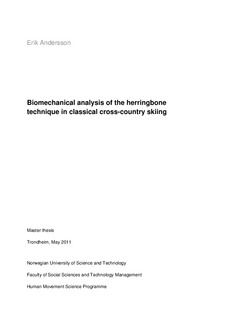| dc.description.abstract | Purpose: To investigate the mechanics of the cross-country herringbone technique and to enhance the understanding of adaptations in kinematics and kinetics due to increasing velocity.
Method: Eleven male elite cross-country skiers performed the herringbone technique at three different velocities; moderate, high and maximal. The slope covered a total distance of 50 m. The first 35 m, at ~7.5° incline, was utilized for acceleration using the diagonal stride technique to reach the desired velocity, followed by an 8 m measuring section (~15° incline) using the herringbone technique. All trials were filmed synchronously using two video cameras placed perpendicular along the section and one moving panning camera. Two photocells were used in order to obtain average section times and velocities. All subjects used ski poles that were constructed for force measurements and the forces directed along the poles was recorded with a sampling rate of 1500 Hz. Vertical plantar pressure was recorded at a rate of 100 Hz using the Pedar Mobile System. The plantar pressure was further converted to plantar ("leg") force.
Results: Cycle rate and cycle length increased synchronously from moderate to high velocity, whereas the increase from a high to a maximal velocity was achieved by a higher cycle rate. The poling and the leg thrust times decreased gradually as velocities increased, whereas the relative poling and leg thrust times were constant; ~50% and ~40%. From moderate to maximal velocities the peak pole forces increased by 74%, in association with a 75% shorter time to peak force. The peak leg force increased by 7% from moderate to high velocity with no further changes at maximal velocity. The time to peak leg force decreased 24%, from moderate to maximal velocity. The force impulse ratio between pole and leg remained constant at ~8% from moderate to maximal velocity and the ratio for propulsion was ~30% due to the higher relative propulsive components from the poles. Changes in joint kinematics across the velocities were negligible, except for the total body lean and the lower leg angle. The angle of the lower leg, at end of the push off, decreased with increased velocity and was negatively correlated to maximal pole/leg force, cycle length and maximal velocity. Strength parameters correlated positively to force distribution between upper and lower body, as well as to maximal velocity.
Conclusions: The adaptation of herringbone velocity between moderate and high velocity was achieved by increased cycle rate and cycle length, whereas the adaptation from high to maximal velocity was achieved only by increased cycle rate. The latter is explained by increased force generation from the upper and lower body, despite decreased poling and leg thrust times, with a constant impulse ratio between the upper and lower body. Higher skiing velocity was primarily assisted by constant body segment and joint angles.
Key Words: CYCLE LENGTH, CYCLE RATE, HERRINGBONE, IMPULSE RATIO, LEG FORCE, POLE FORCE, PROPULSION | nb_NO |
